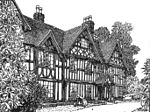Barnt Green railway station
DfT Category F1 stationsFormer Midland Railway stationsRail junctions in EnglandRailway stations in Great Britain opened in 1844Railway stations in Worcestershire ... and 2 more
Railway stations served by West Midlands TrainsUse British English from March 2015

Barnt Green railway station serves the village of Barnt Green, North Worcestershire, England. It is situated 9+1⁄2 miles (15.3 km) south west of Birmingham New Street. The station, and all trains serving it, are operated by West Midlands Trains. Barnt Green station is at the point of a 'Y' shaped junction between the main line towards Bromsgrove, Worcester and the south-east, and the branch line to Redditch which is part of the Cross-City Line. It has platforms on both lines, until 2018 only the Redditch line platforms saw regular services, however since Cross-City Line services were extended to Bromsgrove, the main line platforms now also see regular use.
Excerpt from the Wikipedia article Barnt Green railway station (License: CC BY-SA 3.0, Authors, Images).Barnt Green railway station
Fiery Hill Road,
Geographical coordinates (GPS) Address Nearby Places Show on map
Geographical coordinates (GPS)
| Latitude | Longitude |
|---|---|
| N 52.3607 ° | E -1.9926 ° |
Address
Fiery Hill Road
B45 8LE
England, United Kingdom
Open on Google Maps







